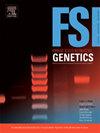Mass spectrometry-based proteomics for source-level attribution after DNA extraction
IF 3.2
2区 医学
Q2 GENETICS & HEREDITY
引用次数: 0
Abstract
Biological traces recovered from crime scenes serve as vital evidence in forensic investigations. While DNA evidence is frequently used to address the sub-source level of the hierarchy of propositions, the biological source of the DNA can be highly probative at the source level. Current body fluid detection methods pose certain limitations, such as reports of false positive results from some of the presumptive and/or confirmatory tests in current use. These tests are also individual tests for the detection of one body fluid, meaning that if the sample is suspected to be a mixture of multiple body fluids, then different tests would need to be conducted to confirm the body fluid(s) present, which may exhaust small amounts of available biological trace. Proteomics applications for the identification of body fluids have been previously explored, and potential biomarkers indicative of body fluids discovered from liquid-chromatography tandem mass spectrometry (LC-MS/MS) methods have been reported. This work focuses on developing a mass spectrometry-based proteomics approach for the identification of body fluids by targeting discriminating peptide biomarkers from the non-DNA component left over after DNA extraction of samples. The non-DNA component is typically a waste product but with unappreciated evidential value. Our methodology for the purification of proteins from the post-DNA extraction waste includes an acetone precipitation and single-pot solid-phase-enhanced sample preparation (SP3) technique, microwave-assisted trypsin digestion, and LC-MS/MS analysis of the resultant peptides. Preliminary results from this proof-of-concept study include a list of potentially discriminating proteins and peptides for blood, saliva, and semen developed from the analysis of post-DNA extraction waste. Our method allows for multiple analytes to be targeted simultaneously from a DNA profiling waste stream and we anticipate that it could eventually be incorporated into standard forensic laboratory workflows.
基于质谱的蛋白质组学,用于 DNA 提取后的源级归属。
从犯罪现场提取的生物痕迹是法医调查的重要证据。虽然 DNA 证据经常被用于处理命题层次中的子来源层次,但 DNA 的生物来源在来源层次上具有很强的证明力。目前的体液检测方法存在一定的局限性,例如有报告称,目前使用的一些推定和/或确证检测方法会出现假阳性结果。这些测试也是检测一种体液的单独测试,这意味着如果怀疑样本是多种体液的混合物,则需要进行不同的测试来确认存在的体液,这可能会耗尽少量可用的生物痕量。蛋白质组学在体液鉴定方面的应用此前已有探索,通过液相色谱串联质谱(LC-MS/MS)方法发现的指示体液的潜在生物标记物也有报道。这项工作的重点是开发一种基于质谱的蛋白质组学方法,通过从样本 DNA 提取后残留的非 DNA 成分中识别肽类生物标记物来鉴定体液。非 DNA 成分通常是一种废品,但其证据价值却未得到重视。我们从 DNA 提取后的废弃物中纯化蛋白质的方法包括丙酮沉淀和单锅固相增强样品制备(SP3)技术、微波辅助胰蛋白酶消化以及对所得肽段进行 LC-MS/MS 分析。这项概念验证研究的初步结果包括通过分析 DNA 提取后的废弃物而得出的血液、唾液和精液中具有潜在鉴别力的蛋白质和肽的列表。我们的方法可同时针对 DNA 分析废物流中的多个分析物进行分析,预计最终可将其纳入标准法医实验室工作流程。
本文章由计算机程序翻译,如有差异,请以英文原文为准。
求助全文
约1分钟内获得全文
求助全文
来源期刊
CiteScore
7.50
自引率
32.30%
发文量
132
审稿时长
11.3 weeks
期刊介绍:
Forensic Science International: Genetics is the premier journal in the field of Forensic Genetics. This branch of Forensic Science can be defined as the application of genetics to human and non-human material (in the sense of a science with the purpose of studying inherited characteristics for the analysis of inter- and intra-specific variations in populations) for the resolution of legal conflicts.
The scope of the journal includes:
Forensic applications of human polymorphism.
Testing of paternity and other family relationships, immigration cases, typing of biological stains and tissues from criminal casework, identification of human remains by DNA testing methodologies.
Description of human polymorphisms of forensic interest, with special interest in DNA polymorphisms.
Autosomal DNA polymorphisms, mini- and microsatellites (or short tandem repeats, STRs), single nucleotide polymorphisms (SNPs), X and Y chromosome polymorphisms, mtDNA polymorphisms, and any other type of DNA variation with potential forensic applications.
Non-human DNA polymorphisms for crime scene investigation.
Population genetics of human polymorphisms of forensic interest.
Population data, especially from DNA polymorphisms of interest for the solution of forensic problems.
DNA typing methodologies and strategies.
Biostatistical methods in forensic genetics.
Evaluation of DNA evidence in forensic problems (such as paternity or immigration cases, criminal casework, identification), classical and new statistical approaches.
Standards in forensic genetics.
Recommendations of regulatory bodies concerning methods, markers, interpretation or strategies or proposals for procedural or technical standards.
Quality control.
Quality control and quality assurance strategies, proficiency testing for DNA typing methodologies.
Criminal DNA databases.
Technical, legal and statistical issues.
General ethical and legal issues related to forensic genetics.

 求助内容:
求助内容: 应助结果提醒方式:
应助结果提醒方式:


